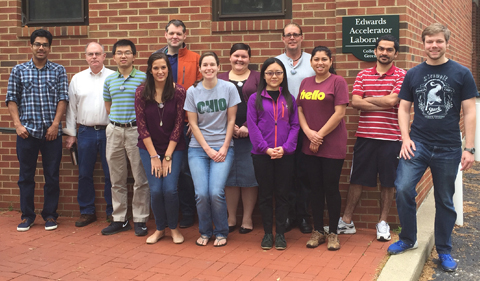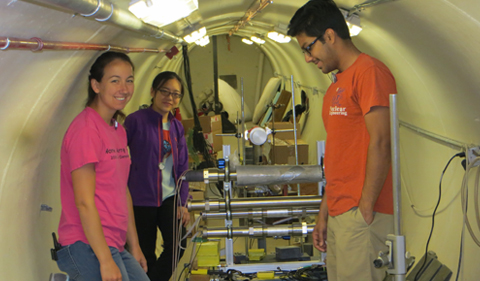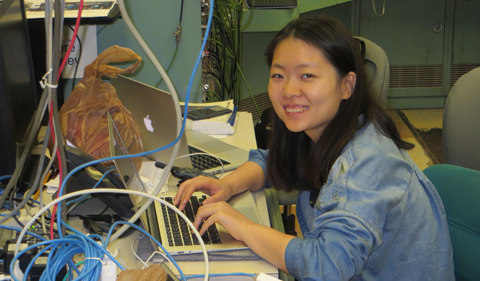
Ohio University Physics & Astronomy research staff and graduate students assist University of Florida researchers in conducting experiments to test neutron detectors used in the nuclear energy industry. From left, Sasmit Gokhale, Don Carter, Haitang Wang, Hannah Gardiner, Dr. Kelly Jordan, Cody Parker, Andrea Richard, Ting Zhu, Devon Jacobs , Shamim Akhtar, Sushil Dhakal, Lucas Rolison (Drs. Tom Massey and Alexander Voinov not shown) Photo: Tom Massey
By Jean Andrews
Physics & Astronomy
Nuclear engineers from the University of Florida recently convened at Ohio University’s Edwards Accelerator Lab for two weeks to conduct experiments on neutron detector characterization—and to help meet the challenge of improving the safety of storing spent nuclear fuel.
Lead researchers are Dr. Andreas Enquist, Assistant Professor of Nuclear Engineering, and Dr. Kelly Jordan, Associate Chair and Director of Nuclear Engineering, both at UF. Dr. Tom Massey, Research Associate Professor in Physics & Astronomy, provided technical support at the Lab.
“The Edwards Accelerator is a world-class facility for the study of nuclear physics,” notes Jordan. “The lab’s unique capabilities enable us to characterize the behavior and performance of our prototype detectors in a way that’s not possible elsewhere. These measurements will help us to build systems that will enhance nuclear security in the U.S. and around the world.”
Partnering with Arktis Detection Systems Inc., a Swiss radiation detection systems business, the scientists’ goal is to understand high pressure helium detectors. The group has a contract with the U.S. Department of Energy Office of Nuclear Energy to help develop these detectors for the purpose of surveying casks of spent fuel.

Setting up the helium detectors are from from left: Catlin Barker, Tin Zhu and Sasmit Gokhal. The round detector is a standard liquid scintillator with organometallic tin added to improve the separation between neutrons and gammas.
Finding Alternative Ways to Verify Spent Fuel Contents
“The direct application is to survey casks of spent fuel rods remotely, to determine the contents, for example, at a nuclear power plant,” says Massey. “Spent fuel is almost exclusively found at nuclear reactors. This work is to verify the content of the casks and to detect any variation in the contents of the cask. This is a nonproliferation study because it prevents diversion of the radioactive material by unwanted parties.”
The older type of detectors previously used for this work are being phased out, Massey says, for various reasons. One of the older detectors used a gas, boron trifluoride, which is toxic. Although the gas was held in the detector by an airtight seal, it was still a concern for use at the sites where the U.S. Department of Homeland Security would use them.
Another type of older detector used a lighter isotope of helium, He-3, which is now very expensive because of the rise of the price of this isotope. The increase in price is due to other industrial and medical uses for He-3, and so a different, less expensive detector technology is needed.

Ting Zhu working on the online analysis of the data
Designing Better Detectors
One of the goals of the project is to evaluate the use of silicon photomultipliers, or SiPM, in physics experiments. Each new detector had a string of SiPM inside the high-pressure vessel to read out the scintillation light from the helium detector. This scintillation light provides information on the number of neutrons that hit the new detector. This new detector technology is less expensive and less toxic than the older detectors that were used before.
In addition to the high-pressure helium detectors, two modern neutron detectors were tested by the group. The most commercial detector was a cerium-activated Cs2LiYCl6 (CLYC) crystal. The Lithium-6 isotope content makes this detector a good choice for low-energy neutron experiments. The second detector was a standard scintillator with a tin organometalic compound added. The tin compound was added to improve the separation between neutron and gamma events.
Spent fuel is difficult to monitor, explains Jordan, because they are stored in thick shielding containers, which limits the information about them. Designing detectors to measure fast neutrons emitted from the fuel and penetrating through the shields provides a rich potential source of information on the condition of the casks.
“Better detectors provide a method of determining that no nuclear material is diverted or removed. By performing measurements at the Edwards Accelerator Lab, we can better understand and interpret future field measurements.”



















Comments